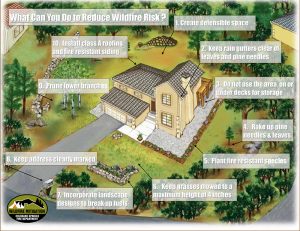As an owner of North Colorado Springs Real Estate myself, the subject of Wildfire Mitigation has been a topic of concern recently. As I show properties to buyers areas such as Rockrimmon and Black Forest, the talk inevitably turns to the recent Waldo Canyon and Black Forest wildfires that did so much damage in the past couple of years. We live in Colorado because we enjoy being outside in nature…amongst the trees and bushes that make this one of the most beautiful places on earth in which to live.
 Unfortunately, as we’ve learned, living that close to nature can have its downsides. The Waldo Canyon Fire destroyed 346 homes and was, at the time, Colorado’s most costly wildfire in terms of damage. Until the Black Forest Fire, which significantly upped the numbers by destroying over 500 homes.
Unfortunately, as we’ve learned, living that close to nature can have its downsides. The Waldo Canyon Fire destroyed 346 homes and was, at the time, Colorado’s most costly wildfire in terms of damage. Until the Black Forest Fire, which significantly upped the numbers by destroying over 500 homes.
The Colorado Springs Fire Department has a highly regarded wildfire mitigation department which exists to help homeowners within the city limits of Colorado Springs assess their risks related to wildfires. They offer free site visits to homes as well as host free seminars for interested groups to learn about wildfire mitigation. They do this in the hopes that those homeowners will then take the necessary steps to mitigate any problems that may ultimately result in the loss of their home in a wildfire situation. Amy Silvester is the Program Coordinator of the Wildfire Mitigation Section of the Colorado Springs Fire Department and recently gave an excellent presentation to our office on some of the things their department looks for when visiting homeowners.
- Types of roofing used on the house. Cedar Shake shingles still exist on many homes in Colorado Springs, and are a huge fire hazard. Tile roofs are better, but interestingly enough do not perform as well as asphalt shingles. The gaps created by some types of tile roofs can actually allow floating embers up underneath them, igniting the roof underneath.
- Types of vegetation close to the house. Juniper bushes and Cedar trees are the most combustible plants. Having these planted right up next to a house is a huge risk.
- Wood decks. These are a big risk in homes near fire zones. Composite decking is better as it tends to melt rather than burn. If you are evacuating because of an approaching fire, leave a sprinkler going on your deck to keep it wet to prevent embers from igniting it.
- Wood Siding. This is no longer allowed by Colorado Springs Building Codes. New alternative is called “Hardy Board”, and is much more fire resistant than wood siding. Stucco is the most fire resistant siding.
- Even stucco homes can burn. Many have exposed wooden ‘weeping’, which can catch fire. Also, soffits are usually wood even on stucco homes. They can be covered in stucco to provide extra protection.
- Wood Fencing. Cedar fencing is very popular here, but it is very flammable. The cedar fencing used in Colorado Springs is actually a huge creator of embers when it burns. If you have Cedar fencing and have a gate at the side of your house, leave it open if you evacuate. This will create a ‘break’ in the flammable fencing so that it doesn’t travel all the way up to the side of your house.
- Mulch. Consider having islands of mulch, and avoid having them right up against the side of the house where, if they burn, they can catch your house on fire.
- “Vertical Arrangement” of fuels. Fires get very dangerous when they travel up into the tops of trees. The goal is to keep the fire crawling along the ground where it is is much easier for firefighters to fight safely. Keeping fuels cut down so that they can’t climb up into the limbs of the larger trees will make a big difference. A good example of this is pine needles that lead up to a bush, which is tall enough that it can catch the branches of a tree on fire.
- “Horizontal Arrangement” of fuels. This is designed to look for gaps in the canopy of trees and bushes. By separating things out horizontally, it makes it harder for the fire to travel from bush to bush (or tree to tree). Create ‘islands’ of vegetation separated by rock or dirt.
- Placement of firewood. This may seem like common sense, but leave piles of firewood at least 20 feet away from the house. Firewood is, by definition, designed to burn easily. Keep it away from the house so that it doesn’t ignite your house with it.
You can find out your home’s specific wildfire hazard rating by using a new interactive online map that shows the risk for your particular lot. Properties within the city limits have all been rated by CSFD, and their color code is reflected on this map. If you live in, or near, the areas marked in red on this map, be prepared to do some mitigation on your property to reduce the risk. A similar map is available on the Colorado state level by going to www.coloradowildfirerisk.com.
There is plenty more information available from the CSFD’s Wildfire Mitigation website.

